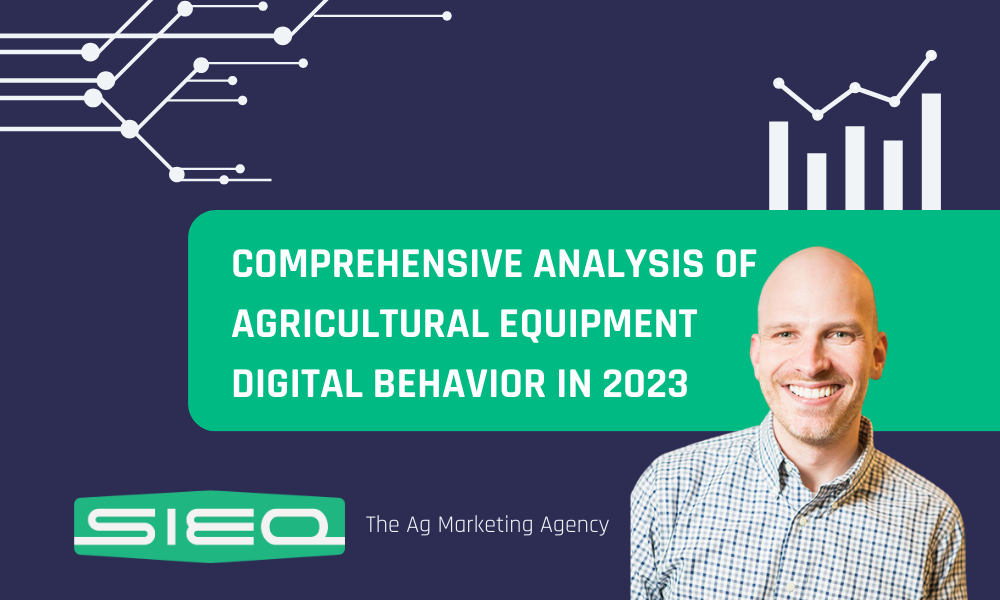Comprehensive Analysis of Agriculture Equipment Consumer Digital Behavior in 2023

Introduction
This in-depth white paper, spearheaded by Tim Whitley of SI EQ, a Google Premier Partner, delves into the evolving digital landscape for researching and purchasing agricultural equipment. This paper provides actionable insights for businesses and marketers within the agriculture industry by examining the customer journey from research to purchase, with special attention on their online search habits.
Methodology
As a Google Premier Partner, Google provides SI EQ with exclusive data that gives us deep insights in these fields.
First, let’s define the key performance metrics extracted from Google's search index:
Queries: Total searches conducted by users related ONLY to agricultural equipment.
Ad Depth: The number of ads shown per search query.
Impressions: The frequency of ad displays in response to these queries.
Clicks: The number of times users engaged with ads or organic search results.
To reiterate, all data provided is pulled from the agricultural equipment targeting segment. It is also a Year-Over-Year (YoY) analysis showcasing how the customer journey changed in just 12 months.
Findings and Analysis
Search Query Trends
Search Growth: In 2023, most research and purchase decisions were made on mobile devices. Mobile search accounted for 72% of all search activity for equipment.
Mobile has predominantly been the gateway for search activity in this industry since 2016. In 2023, we saw yet another increase of 5%
In the last few years, search activity on computers increased by 7% but only made up 26% of the total volume of searches, YoY
The number of searches decreased by 10% and only made up 2% of the total volume of searches YoY
The total number of searches for agricultural equipment increased by 5% in 2023 vs 2022. Queries go from broad to precise terms within the customer journey. The user will start with a branded term or a generic term such as “compact tractor” and will usually become more precise with model numbers after their initial search.
Ad Depth and Market Competition
Competition increased 4% YoY inside of the customer journey within Google.
Competition Intensity on Mobile: Mobile searches faced 12.9 competitors, more than tablet and computer searches, emphasizing the competitive digital environment for agricultural equipment.
Even though there are much fewer searches on tablets, we did see the Ad Depth increase by 5%, resulting in customers viewing 11.8 competitors within their customer journey on tablets.
Computers saw a decrease in the number of advertisers by 3%, resulting in only 10.2 competitors within their customer journey on computers.
Understanding the Ad Depth and Market Competition increases the need for relevant ad copy and destination pages. It also underscores the importance of delivering the right message to this audience on their first query while researching products. In 2023, we saw higher click-through rates for competitive pricing and value to customers' needs.
Increasing Ad Depth: Ad-depth (number of competitors) has increased 4% YoY and has dramatically increased since 2020.
It should be noted that not all competitors are actual competitors. For example, Google cannot see the difference between manufacturers, regional and local advertising from the same brand. They are all competitors in the eyes of Google, which increases Ad Depth and cost-per-click.
Clicks and Engagement Patterns
Clicks on paid and organic searches increased by 15% on mobile, YoY. This indicates that more research is being conducted within the customer journey. An increase of 5% of total queries but an increase of clicks of 15% indicates an increase in the length and depth of the customer journey process, clicking on more links within the search page after a query is made.
Early-Year Click Surge: February-April 2023 experienced higher click rates, suggesting a solid consumer intent in researching equipment before the planting season. The click surge topped out in May, but April came in a close second place.
There is a new emergence of an increase in intent with clicks in October and November. Over the last two years, October and November showcased another peak in click-through rates on paid and organic searches. We know end-of-the-year sales with used equipment have existed at the physical store level for decades, but that has now translated to online research and shopping.
The overall click growth was 10%. Mobile was up 15%, which encompasses 72% of all queries, and where leads are generated, making it the most critical metric. Tablet-based searches had a decrease of 5%.
Seasonal Patterns
A basic understanding of all equipment manufacturers is the knowledge of a seasonal pattern in researching equipment online. This still holds true and becomes even more prominent as every equipment brand is tasked to increase its market share.
Queries began to increase in March and peaked in May 2023. It only slightly decreased in June, steadily declining through November 2023. January and February had the lowest number of queries throughout the entire year. December remained 20 points higher than January and February.
Ad Depth has become more aligned with the customer journey for the first time in the history of these reports. Mobile Ad Depth peaked at 15 competitors compared to 13 in May 2022. It peaked again in October 2023 and then steadily decreased throughout the rest of 2023.
Impressions on advertising for agricultural equipment followed the same pattern as queries.
Clicks on paid and organic search results aligned with the query data, but did showcase a higher click-through rate in April 2023 and October 2023, differing from Query and Impression data. This showcases an additional intent for the number of queries vs clicks in April and October.
Organic search focus and paid search should never shut off for this audience, regardless of the number of queries. Staying active on search engines ensures you don't fall behind as evidenced by the competition present in ad-depth metrics.
Implications for Marketing Strategies
Strategic Focus on Mobile Platforms: Given the significant customer reliance on mobile devices, businesses must develop mobile-centric platforms and marketing strategies.
Ecommerce: This audience must purchase products and services via mobile on business websites that meet their needs.
Capitalizing on Seasonal Highs: Marketing campaigns should be intensified during high-engagement periods, especially from February to June, but do not discount the high intent of clicks from October to December. There are fewer queries but more intent via clicks.
Campaigns are always on: Due to the number of Ad Competitors, you must be on with your marketing campaigns 12 months out of the year. Budget fluctuations will be needed, as seasonal highs will require 2-4 times the amount in paid search vs. January to reach the same share of voice.
Navigating the VERY Competitive Digital Arena: Understanding ad depth and competition can assist businesses in creating distinctive strategies to emerge prominently in a competitive market.
Recommendations for Future Strategy
Ensure your copy for paid search and organic meta tags relates to the potential customer; you are surrounded by competitors who might be messaging better with incentives, tractor packages or value propositions.
Data-Driven Marketing Initiatives: Utilize analytics to tailor marketing efforts, aligning them with observed consumer behavior patterns.
Adaptive Content Strategy: Develop content and advertising strategies that resonate with the observed seasonal trends, ensuring relevance and engagement.
Do not discount October and November from a customer journey perspective for used equipment. They are shopping online. They are going outside your AOR to purchase equipment that fits their needs. Marketing initiatives are now necessary to capture this audience, as it was not necessarily crucial before 2020.
Manufacturers, Regional Incentives and Local Dealer Advertising are competing against each other for Ad Depth in Google’s eyes. Understand what each layer is doing inside of Google search to help:
Dominate SERP (search engine results page) with your brand.
Understand what search absolute top impression rate you are each trying to achieve
Which keywords are being focused on to bid with or against
Paid Search Recommendations: Better ads mean better Ad Rank
Every time someone does a search that triggers an ad that's competing in an auction, Google calculates an Ad Rank. This calculation incorporates your bid and auction-time measurements of expected CTR, ad relevance and landing page experience, among other factors. To determine the auction-time quality components, Google weighs a number of different factors. By improving the following factors, we can help improve the quality components of your Ad Rank:
Your ad's expected clickthrough rate: This is partly based on your ad's historical clicks and impressions (adjusting for factors such as assets and other formats that may have affected the visibility of an ad that someone previously clicked)
Your ad’s relevance to the search: How relevant your ad is to what a person searches for
The quality of your landing page: How relevant, transparent and easy to navigate your page is
Why ad quality matters
The quality components of Ad Rank are used in several different ways and can affect the following things:
Ad auction eligibility: Google’s measures of ad quality help determine the Ad Rank thresholds for your ad and whether your ad is qualified to appear at all.
Your actual cost-per-click (CPC): Higher-quality ads often lead to lower CPCs. That means you pay less per click when your ads are of higher quality.
Eligibility for ad assets and other ad formats: Ad Rank determines whether or not your ad is eligible to be displayed with ad assets and other ad formats, such as site links.
Overall, higher-quality ads typically lead to lower costs and more advertising success. The Google Ads system works best for everybody when the ads shown are relevant and closely match what customers are searching for.
Conclusion
The digital journey of agricultural equipment consumers is increasingly shaped by their interactions with online platforms, mainly through mobile devices. For businesses selling agricultural equipment, adapting to these digital trends is crucial. Emphasizing mobile optimization, strategic ad placements and seasonally targeted marketing efforts are essential to effectively reaching and engaging your target audience. This comprehensive analysis highlights the necessity of leveraging digital analytics to inform and refine marketing strategies in the agricultural industry.
About SI EQ
Since 2010, SI EQ has been at the forefront of innovation in the agriculture marketing space. From developing our own CRM program for agricultural equipment dealers to our proprietary audience targeting, we live and breathe this industry. Whatever your business objectives or goals may be, SI EQ can help you reach them.



